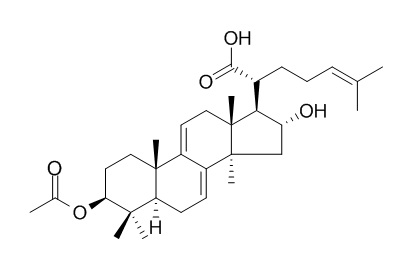3-O-Acetyl-16 alpha-hydroxydehydrotrametenolic acid
3-O-Acetyl-16 alpha-hydroxydehydrotrametenolic acid shows anti-inflammatory activity, it can inhibit NO production and iNOS expression in LPS-stimulated Raw264.7 cells.
Inquire / Order:
manager@chemfaces.com
Technical Inquiries:
service@chemfaces.com
Tel:
+86-27-84237783
Fax:
+86-27-84254680
Address:
1 Building, No. 83, CheCheng Rd., Wuhan Economic and Technological Development Zone, Wuhan, Hubei 430056, PRC
Providing storage is as stated on the product vial and the vial is kept tightly sealed, the product can be stored for up to
24 months(2-8C).
Wherever possible, you should prepare and use solutions on the same day. However, if you need to make up stock solutions in advance, we recommend that you store the solution as aliquots in tightly sealed vials at -20C. Generally, these will be useable for up to two weeks. Before use, and prior to opening the vial we recommend that you allow your product to equilibrate to room temperature for at least 1 hour.
Need more advice on solubility, usage and handling? Please email to: service@chemfaces.com
The packaging of the product may have turned upside down during transportation, resulting in the natural compounds adhering to the neck or cap of the vial. take the vial out of its packaging and gently shake to let the compounds fall to the bottom of the vial. for liquid products, centrifuge at 200-500 RPM to gather the liquid at the bottom of the vial. try to avoid loss or contamination during handling.
Korea Institute of Oriental Medicine2020, doi: 10.21203.
Chemistry of Plant Materials.2019, 215-222
Oncotarget.2017, 8(64):108006-108019
Mol Immunol. 2016, 78:121-132
Korean Journal of Pharmacognosy.2020, 51(2):100-106
Neurotox Res.2022, 40(6):1937-1947.
Horticulturae2024, 10(5), 486.
In Vitro Cellular & Developmental Biology - Plant 2021, 57:874ĘC882.
QASCF2022, 14(4).
J Lipid Res.2024, 65(10):100640.
Related and Featured Products
Bioorg Chem. 2017 Feb;70:94-99.
Bioactivity-guided isolation of anti-inflammatory triterpenoids from the sclerotia of Poria cocos using LPS-stimulated Raw264.7 cells.[Pubmed:
27912907 ]
Poria cocos Wolf (Polyporaceae) has been used as a medicinal fungus to treat various diseases since ancient times. This study aimed to investigate the anti-inflammatory chemical constituents of the sclerotia of P. cocos.
METHODS AND RESULTS:
Based on bioassay-guided fractionation using lipopolysaccharide (LPS)-stimulated Raw264.7 cells, chemical investigation of the EtOH extract of the sclerotia of P. cocos resulted in the isolation and identification of eight compounds including six triterpenoids, namely poricoic acid A (1), 3-O-Acetyl-16 alpha-hydroxydehydrotrametenolic acid(2), polyporenic acid C (3), 3╬▓-hydroxylanosta-7,9(11),24-trien-21-oic acid (4), trametenolic acid (5), and dehydroeburicoic acid (6), as well as (-)-pinoresinol (7) and protocatechualdehyde (8). The structures of the isolated compounds were determined by spectroscopic analysis, including 1H and 13C NMR spectra, and LC/MS analysis. The anti-inflammatory activities of the isolates were evaluated by estimating their effect on the production of nitric oxide (NO) and prostaglandin E2 (PGE2) in LPS-stimulated Raw264.7 as well as on the expression of inducible nitric oxide synthase (iNOS) and cyclooxygenase-2 (COX-2). Compounds 1-5 inhibited NO production and iNOS expression in LPS-stimulated Raw264.7 cells. Among them, compound 1 exerted the highest anti-inhibitory activity and reduced PGE2 levels via downregulation of COX-2 protein expression.
CONCLUSIONS:
The findings of this study provide experimental evidence that the sclerotia of P. cocos are a potential source of natural anti-inflammatory agents for use in pharmaceuticals and functional foods. Furthermore, the most active compound 1, seco-lanostane triterpenoid, could be a promising lead compound for the development of novel anti-inflammatory agents.
J Chromatogr B Analyt Technol Biomed Life Sci. 2015 Nov 1;1004:10-6. doi: 10.1016/j.jchromb.2015.09.017. Epub 2015 Sep 26.
One-step separation of nine structural analogues from Poria cocos (Schw.) Wolf. via tandem high-speed counter-current chromatography.[Pubmed:
26435185]
A novel one-step separation strategy-tandem high-speed counter-current chromatography (HSCCC) was developed with a six-port valve serving as the switch interface.
METHODS AND RESULTS:
Nine structural analogues including three isomers were successfully isolated from Poria cocos (Schw.) Wolf. by one step. Compared with conventional HSCCC, peak resolution of target compounds was effectively improved in tandem one.
Purities of isolated compounds were all over 90% as determined by HPLC. Their structures were then identified via UV, MS and (1)H NMR, and eventually assigned as poricoic acid B (1), poricoic acid A (2), 3╬▓,16╬▒-dihydroxylanosta-7, 9(11), 24-trien-21-oic acid (3), dehydrotumulosic acid (4), polyporenic acid C (5), 3-epi-dehydrotumulosic acid (6), 3-O-Acetyl-16 alpha-hydroxydehydrotrametenolic acid (7), dehydropachymic acid (8) and dehydrotrametenolic acid (9) respectively.
CONCLUSIONS:
The results indicated that tandem HSCCC can effectively improve peak resolution of target compounds, and can be a good candidate for HSCCC separation of structural analogues.



